 Tìm kiếm
Tìm kiếm
Luật thuế thu nhập doanh nghiệp sửa đổi năm 2013 số 32/2013/QH13
| Số hiệu: | 32/2013/QH13 | Loại văn bản: | Luật |
| Nơi ban hành: | Quốc hội | Người ký: | Nguyễn Sinh Hùng |
| Ngày ban hành: | 19/06/2013 | Ngày hiệu lực: | 01/01/2014 |
| Ngày công báo: | 13/07/2013 | Số công báo: | Từ số 407 đến số 408 |
| Lĩnh vực: | Doanh nghiệp, Thuế - Phí - Lệ Phí | Tình trạng: | Còn hiệu lực |
TÓM TẮT VĂN BẢN
Văn bản tiếng việt
Văn bản tiếng anh
|
NATIONAL ASSEMBLY |
SOCIALIST REPUBLIC OF VIETNAM |
|
Law No. 32/2013/QH13 |
Hanoi, June 19, 2013 |
ON THE AMENDMENTS TO THE LAW ON CORPORATE INCOME TAX
Pursuant to the Constitution of Socialist Republic of Vietnam 1992, amended in the Resolution No. 51/2001/QH10;
The National Assembly promulgates a law on the amendments to the Law on Corporate income tax No. 14/2008/QH12.
Article 1. The amendments to the Law on Corporate income tax:
1. Clause 3 of Article 2 is amended as follows:
“3. The permanent establishments of a foreign enterprise are the places through which the foreign enterprise carries out part or the whole business in Vietnam, including:
a) Branches, executive offices, factories, workshops, means of transport, oil fields, gas files, miles or other natural resource extraction sites in Vietnam;
b) Construction sites;
c) Service providing centers, including counseling services via employees or other organizations or individuals;
d) Agents of foreign enterprises;
dd) Representatives in Vietnam that are competent to sign contracts under the name of the foreign enterprise or that are not competent to sign contracts under the name of the enterprise but regularly provide goods or services in Vietnam.”
2. Clause 2 of Article 3 is amended as follows:
“2. Other incomes include incomes from the transfer of capital, the right to capital contribution; incomes from transfer of real estate, investment project, the right to participate in investment project, the transfer of the right to explore, extract, and process minerals; incomes from the right to use property and property ownership, including incomes form intellectual property right; incomes from transferring, leasing, and liquidating assets, including valuable papers; incomes from interest on deposit, capital loan, sale of foreign currency; revenues from written of bad debts that are repaid; revenues from debts of unidentified debtors; omitted incomes in previous years, and other incomes, including incomes from business outside Vietnam.”
3. Clause 1 and Clause 4 of Article 4 is amended, Clauses 8, 9, 10, and 11 are added to Article 4 as follows:
“1. incomes from farming, breeding, aquaculture, salt production of cooperatives; incomes of cooperatives from agriculture, forestry, fisheries, and salt production in disadvantaged areas or extremely disadvantaged areas; incomes of enterprises from farming, breeding, aquaculture in extremely disadvantaged areas; incomes from fisheries.”
“4. Incomes from production and sale of goods and services of enterprises that have at least 30% of the employees are disabled people, detoxified people, suffers of HIV/AIDS, and have at least 20 employees, except for enterprises engaged in finance and real estate business.”
“8. Incomes from the transfer of Certified Emissions Reductions (CERs) of enterprises issued with CERs.
9. Incomes from the performance of tasks of the Vietnam Development Bank, which are assigned by the State, in credit for development and export; incomes from granting credit to the poor and beneficiaries of policies of Vietnam Bank for Social Policies; incomes of state financial funds and other state funds serving non-profit purpose incomes of organizations, of which 100% charter capital is possessed by the State, that are established by the Government to settle bad debts of Vietnamese credit institutions.
10. Undistributed incomes of private organizations, which make investment in education, health, and other fields, that are kept to serve their development in accordance with the laws on education, health, and other fields; the incomes that form the undistributed assets of cooperatives established and operating in accordance with the Law on Cooperatives.
11. Incomes from transfer of technologies that are prioritized to be to organizations and individuals in extremely disadvantaged areas.”
4. Clause 3 of Article 7 is amended as follows:
“3. Incomes from transfers of real estate, investment project, the right to participate in investment projectss, the right to explore, extract, and process minerals must be separated. The loss on transfers of investment projects (except for mineral exploration and mineral extraction projects), incomes from transfers of the right to participate in investment projects (except for the mineral exploration and mineral extraction projects), incomes from transfer of real estate shall be offset against the profit in the tax period.”
5. Article 9 is amended as follows:
“Article 9. Deductible and non-deductible expenditures
1. Except for the expenditures mentioned in Clause 2 of this Article, all expenditures are deductible when calculating taxable income if they meet the conditions below:
a) Actual expenditures related to the business of the enterprise; expenditures on National defense and security of enterprise according to law;
b) Expenditures that have sufficient invoices and documents according to law. The invoice for any purchase of goods or services of at least 20 million VND must be enclosed with proof of cashless payment, except for the cases in which proof of cashless payment is not required by law.
2. Non-deductible expenditures when calculating taxable income:
a) The expenditures that fail to meet all conditions in Clause 1 of this Article, except for the loss cause by natural disasters, epidemics, and other force majeure that are not compensated.
b) Fines for administrative violations;
c) The expenditures that are covered by other budgets;
d) The administrative expense allocated by the foreign enterprise to the permanent establishment in Vietnam that exceeds the limit imposed by Vietnam’s law.
dd) The extra expenditure according to the laws on making provision;
e) The expenditure on interest on loans that are not given by credit institutions or economic organizations and exceed 150% of basic interest rates announced by the State bank of Vietnam when the loan is taken.
g) Improper depreciation of fixed assets;
h) Improper prepaid expenses;
i) Wages and remunerations of owners of private enterprises; wages of founders that do not participate in business management; wages, remunerations, and amounts payables to the employees that are not actually paid or do not have invoices according to law;
k) The expenditures on loan interests corresponding to the charter capital deficit;
l) Deducted input VAT, VAT paid using the credit-invoice method, corporate income tax;
m) The expenditure on advertising, marketing, promotion, commissions, receptions, conferences, support for marketing and expenditures directly related to business that exceed 15% of the deductible amount. The total deductible amount does not include the expenditures in this Point; for commercial activities, the total deductible amount does not include the purchase prices of goods;
n) Donations, except for donations for education, health, scientific research, disaster recovery, houses of unity, houses of gratitude, houses for beneficiaries of social policies according to law, donations for extremely disadvantaged areas according to state programs;
o) Voluntary payments to retirement funds or social security funds, payments for voluntary retirement insurance for employees that exceed the limits imposed by law;
p) Expenditures on businesses: banking, insurance, lottery, securities, and some other special businesses specified by the Minister of Finance.
3. Expenditures in foreign currency, unless to serve the calculation of taxable incomes that must be converted into VND, according to the average exchange rates on the interbank foreign currency market that are announced by the State bank of Vietnam when the expenditures occur.
The Government shall elaborate and provide guidance on the implementation of this Article.”
6. Article 10 is amended as follows:
“Article 10. Tax rate
1. The corporate income tax rate is 22%, except for the cases in Clause 2 and Clause 3 of this Article and beneficiaries of tax incentives defined in Article 13 of this Article.
From January 1st 2016, the tax rate of 20% shall apply to the cases to which the tax rate of 22% in this Clause applies.
2. Any enterprise whose total revenue in the year does not exceed 20 billion VND shall be eligible for applying the tax rate of 20%.
The revenue used as the basis for identifying enterprises eligible for the tax rate of 20% in this Clause is the revenue of the previous year.
3. The rates of corporate income tax on the exploration and extraction of oil and other rare resources in Vietnam range between 32% and 50% depending on each project and each business establishment.
The Government shall elaborate and provide guidance on the implementation of this Article.”
7. Article 13 is amended as follows:
“Article 13. Tax incentives
1. The tax rate of 10% shall apply for 15 years to:
a) Incomes of enterprises from the execution of new investment projects in extremely disadvantaged areas, economic zones, and hi-tech zones;
b) Incomes of enterprises from the execution of new investment projects, including: scientific research and technology development; application of high technologies in the list of prioritized high technologies according to the Law on High Technologies; cultivation of high technologies, cultivation of hi-tech enterprises; high-risk investment in the development of high technologies in the list of prioritized high technologies according to the Law on High Technologies; investment in crucial infrastructure of the State; software production; production of composite materials, light building materials, rare materials, renewable energy, clean energy, energy from waste destruction; development of biological technology, and environment protection;
c) Incomes of hi-tech enterprises and agricultural enterprises that apply high technologies according to the Law on High Technologies;
d) Incomes of enterprises from the execution of new investment projects in production (except for the production of articles subject to excise duties and mineral extraction projects), which meet one of the two criteria below:
- Any project of which the capital is at least 6,000 billion VND that is released within 3 years from the day on which the Investment certificate is issued, and the total revenue reaches at least 10,000 billion VND within 3 years from the first year in which revenue is earned;
- Any project of which the capital is at least 6,000 billion VND that is released within 3 years from the day on which the Investment certificate is issued, and employ more than 3,000 workers.
2. The tax rate of 10% shall apply to:
a) Incomes of private enterprises from investment in education, vocational training, health, culture, sports, and environment;
b) Incomes of enterprises from the investments in social housing that are for sale, for lease, or for hire purchase according to Article 53 of the Law on Housing;
c) Incomes from press agencies from printing newspapers, including advertisements on printed newspapers according to the Law on Press; incomes of publishers from publishing according to the Law on Publishing;
d) Incomes of enterprises from: planting, cultivating, protecting forests; cultivating, processing agriculture and aquaculture products in disadvantaged areas; producing forestry products in a disadvantaged area; producing, propagating, cross-breeding plants and animals; producing and refining salt, except for the types of salt defined in Clause 1 Article 4 of this Law; investment in preservation of harvested farm produce, preservation of agriculture products, aquaculture products, and foods;
dd) Incomes of cooperatives from agriculture, forestry, fisheries, and salt production that are not in disadvantaged areas or extremely disadvantaged areas, except for incomes of the cooperatives defined in Clause 1 Article 4 of this Law.
3. The tax rate of 20% shall apply for 15 years to:
a) Incomes of enterprises from the execution of new investment projects in disadvantaged areas;
b) Incomes of enterprises from the execution of new investment projects, including: production of high-grade steel; production of energy-saving products; production of machinery and equipment serving agriculture, forestry, aquaculture, salt production; production of irrigation equipment; production and refinement of feed for livestock, poultry, and aquatic organism; development of traditional trades.
From January 01, 2016, incomes of the enterprises defined in this Clause are eligible for the tax rate of 17%.
4. The tax rate of 20% shall apply to incomes of people's credit funds and microfinance institutions.
From January 01, 2016, incomes of people's credit funds and microfinance institutions are eligible for the tax rate of 17%.
5. For special projects that need to attract a lot of investment and high technologies, the period of preferential tax rates may be extended, but the extension shall not exceed 15 years.
6. The period of preferential tax rates in this Article begins from the first year in which revenue from the new investment project is earned; for hi-tech enterprises and agricultural enterprises that apply high technologies, this period begins from the day on which the certificate of hi-tech enterprise or certificate of hi-tech agricultural enterprise is issued; for projects of high technology application, this period begins from the day on which the certificate of hi-tech application project is issued.
The Government shall elaborate and provide guidance on the implementation of this Article.”
8. Article 14 is amended as follows:
“Article 14. Preferential duration of tax exemption and tax reduction
1. Incomes of enterprises from the execution of new investment projects provided for in Clause 1 and Point a Clause 2 Article 13 of this Law, incomes of hi-tech enterprises, hi-tech agricultural enterprises are eligible for tax exemption for up to 4 years, and eligible for 50% tax reduction for up to 9 more years.
2. Incomes of enterprises from the execution of new investment projects provided for in Clause 3 Article 13 of this Law, incomes of enterprises from the execution of new investment projects in industrial parks, except for industrial parks in advantaged areas, are eligible for tax exemption for no more than 2 years, and eligible for 50% reduction in tax for no more than the next 4 years.
3. The period of tax exemption and tax reduction applicable to incomes of enterprises from the execution of new investment projects in Clause 1 and Clause 2 of this Article begins from the first year in which taxable income from the investment projects is earned. If no taxable income is earned in the first three years from the first year in which revenue from the project is earned, the period of tax exemption and tax reduction shall begin from the fourth year. The period of preferential tax rates applicable to hi-tech enterprises and agricultural enterprises that apply high technologies mentioned in Point c Clause 1 Article 13 of this Law begins from the date of issuance of the certificate of hi-tech enterprise or certificate of hi-tech agricultural enterprise.
4. When an enterprise, which has investment projects in the fields or areas eligible for corporate income tax incentives according to this Law, expands the production scale, increases the productivity, upgrades production technologies (expansion), it may choose between tax incentives for operating projects for the remaining time (if any) or tax exemption or reduction for the additional incomes from expansion if one of the three criteria in this Clause is satisfied. The period of tax exemption and tax reduction for the additional incomes from expansion in this Clause is equal to the period of tax exemption and tax reduction for new investment projects in the same field or area that is eligible for corporate income tax incentives.
The expansion must satisfy one of the criteria below to be given incentives:
a) The cost of additional fixed assets reaches at least 20 billion VND when the investment project is completed and commenced, applicable to expanding investments in the fields eligible for corporate income tax incentives according to this Law, or at least 10 billion VND, applicable to expanding investments in disadvantaged or extremely disadvantaged areas;
b) The proportion of cost of additional fixed assets reaches at least 20% of the total cost of fixed assets before investment;
c) The designed capacity increases by at least 20% after investment.
In case an enterprise invests in expansion in a field or area eligible for tax incentives according to of this Law but fails to satisfy any of the three criteria above, the tax incentives shall apply to the remaining operating period of the project (if any).
If an enterprise is eligible for tax incentives for expansion, the additional income from expansion shall be recorded separately; if it is not able to be recorded separately, the income from expansion shall be determined according to the ratio of the cost of new fixed assets to the total cost of fixed assets of the enterprise.
The period of tax exemption and tax reduction in this Clause begins from the year in which the investment project is finished and its operation is commenced.
The tax incentives in this Clause do not apply to extensions on account of merger or acquisition of enterprises or investment projects in operation. The Government shall elaborate and provide guidance on the implementation of this Article.”
9. Clause 3 is added to Article 15 as follows:
“3. Any enterprise that transfers prioritized technologies to other organizations and individuals in disadvantaged areas shall be eligible for 50% reduction in corporate income tax on the income from technology transfers.”
10. Article 16 is amended as follows:
“Article 16. Transferring loss
1. An enterprise may transfer its loss to the next year; this loss is deducted from assessable income. The period of loss transfer must not exceed 5 years from the year succeeding the year in which the loss is incurred.
2. Any enterprise which is still at a loss after offsetting its loss on transfers of real estate, transfers of investment projects, transfers of the right to participate in investment project, according to Clause 3 Article 7 of this Law, and any enterprise which makes a loss from transfers of the right to explore and extract minerals may transfer the loss to the next year and offset it against the assessable incomes from such activities. The period of loss transfer shall comply with Clause 1 of this Article.”
11. Clause 1 of Article 17 is amended as follows:
“1. Any enterprise established and operated within Vietnam’s law may use no more than 10% of the annual assessable income to establish its science and technology development fund. Apart from establishing the science and technology development fund, state-owned enterprise must ensure the minimum amount for the fund according to the laws on science and technology.”
12. Article 18 is amended as follows:
“Article 18. Conditions for tax incentives
1. The corporate income tax incentives provided for in Article 13, 14, 15, 16, and 17 of this law are applicable to the enterprises that follow the regime for accounting and invoicing, and pay tax according to declarations.
Corporate income tax incentives for new investment project defined in Article 13 and Article 14 of this Law are not applicable to division, merger, amalgamation, and conversion of enterprises, change of ownership, and other cases according to law.
2. Enterprises must separate the incomes from the operations eligible for tax incentives defined in Article 13 and Article 14 of this Law from the incomes from the operations that are not eligible for tax incentives; if such incomes are not able to be separated, the income from the operations eligible for tax incentives shall be determined based on the ratio of the revenue from the operations eligible for tax incentives to the total revenue of the enterprise.
3. The tax rate of 20% in Clause 2 Article 10 and the tax incentives in Clause 1 and Clause 4 Article 4, Article 13, and Article 14 of this Law are not applicable to:
a) Incomes from transfer of capital, transfers of the right to contribute capital; incomes from the transfers of real estate, except for social housing specified in Article 13 of this Law; incomes from transfers of investment projects, transfers of the right to participate in investment projectss, transfers of the right to explore and extract minerals; incomes from operations outside Vietnam;
b) Incomes from the exploration and extraction of petroleum and other rare resources, and incomes from mineral extraction;
c) Incomes from services subject to excise duty according to the Law on Excise duty;
d) Other cases decided by the Government.
4. If an enterprise is eligible to multiple tax incentives for the same income at the same time, it may choose the most advantageous incentive.”
1. This Law takes effect on January 01, 2014, except from Clause 2 of this Article.
2. The regulations on the application of the tax rate of 20% to the enterprises of which the total annual revenue does not reach 20 billion VND in Clause 6 Article 1, and the regulations on the application of the tax rate of 10% to the incomes of enterprises from the social housing in Clause 7 Article 1 of this Law takes effect on July 01, 2013.
3. The enterprises having investment projects that are still eligible for corporate income tax incentives after the end of the tax period 2013 (tax rate, tax exemption or reduction duration) according to the legislative documents on corporate income tax before this Law takes effect are still eligible for such incentives for the remaining time according to such documents. Where the conditions for tax incentives in this Law are satisfied, enterprises may choose between the incentives they are having or the incentives in this Law for the remaining time, applicable to new investments or extension.
By the end of the tax period 2015, enterprises having investment projects that are eligible for the preferential tax rate of 20% in Clause 3 Article 13 of the Law on Corporate income tax No. 14/2008/QH12 amended in Clause 4 Article 1 of this Law are eligible for the tax rate of 17% for the remaining time from January 01, 2016.
4. The following regulations on corporate income tax are annulled:
a) Clause 2 Article 7 of the Law on Deposit insurance No. 06/2012/QH13;
b) Clause 2 Article 4 of the Law on Health insurance No. 25/2008/QH12;
c) Clause 1 of Article 10; Clause 1 of Article 12; Clause 2 of Article 18; Clause 2 of Article 19; Clause 1 and Clause 2 of Article 22; Clause 3 of Article 24 and Clause 2 of Article 28 of the Law on High Technologies No. 21/2008/QH12;
d) Clauses 1, 4, 5, 6, 7, and 8 of Article 44, and Article 45 of the Law on Technology transfers No. 80/2006/QH11;
dd) Clause 1 of Article 53, Clause 5 of Article 55, and Clause 3 of Article 86 of the Law on Enterprises No. 76/2006/QH11;
e) Clause 1 of Article 68 of the Law on Vietnamese guest workers No. 72/2006/QH11;
g) Clause 2 Article 6 of the Law on Social insurance No. 71/2006/QH11;
h) Clause 3 Article 8 of the Law on Legal Assistance No. 69/2006/QH11;
i) Clause 3 Article 66 of the Law on Higher Education No. 08/2012/QH13;
k) Article 34 of the Law on Disabled people No. 25/2008/QH12;
l) Clause 4 Article 33 of the Law on Investment No. 59/2005/QH11;
m) Clause 2 of Article 58, Clause 2 of Article 73, Clause 3 of Article 117, and Clause 3 of Article 125 the Law on Enterprises no, 60/2005/QH11.
5. The Government shall elaborate and provide guidance on the implementation of this Law.
This Law is passed by the 13th National Assembly of Socialist Republic of Vietnam in the 5th session on June 19, 2013.
|
|
PRESIDENT OF THE NATIONAL ASSEMBLY |
Cập nhật
Bài viết liên quan
Việc trích lập quỹ phát triển khoa học và công nghệ của doanh nghiệp năm 2024 quy định thế nào?

Việc trích lập quỹ phát triển khoa học và công nghệ của doanh nghiệp năm 2024 quy định thế nào?
Doanh nghiệp ngoài nhà nước được khuyến khích thành lập Quỹ phát triển khoa học và công nghệ của mình hoặc đóng góp vào Quỹ phát triển khoa học và công nghệ của ngành, địa phương và được hưởng quyền lợi theo quy định của Quỹ. Vậy việc trích lập quỹ phát triển khoa học và công nghệ của doanh nghiệp năm 2023 quy định thế nào? Bạn hãy cùng tìm câu trả lời thông qua bài viết dưới đây nhé. 16/11/2024Các hình thức ưu đãi thuế thu nhập doanh nghiệp theo pháp luật hiện hành

Các hình thức ưu đãi thuế thu nhập doanh nghiệp theo pháp luật hiện hành
Việc nắm vững các hình thức ưu đãi thuế thu nhập doanh nghiệp là vô cùng quan trọng đối với các doanh nghiệp, đặc biệt trong bối cảnh cạnh tranh ngày càng khốc liệt như hiện nay. Chính sách ưu đãi thuế không chỉ giúp doanh nghiệp giảm bớt gánh nặng tài chính mà còn tạo động lực thúc đẩy sản xuất kinh doanh. Bài viết này sẽ cung cấp một cái nhìn tổng quan về các hình thức ưu đãi thuế thu nhập doanh nghiệp theo quy định của pháp luật Việt Nam. 15/11/2024Quy định về miễn, giảm thuế thu nhập doanh nghiệp năm 2024
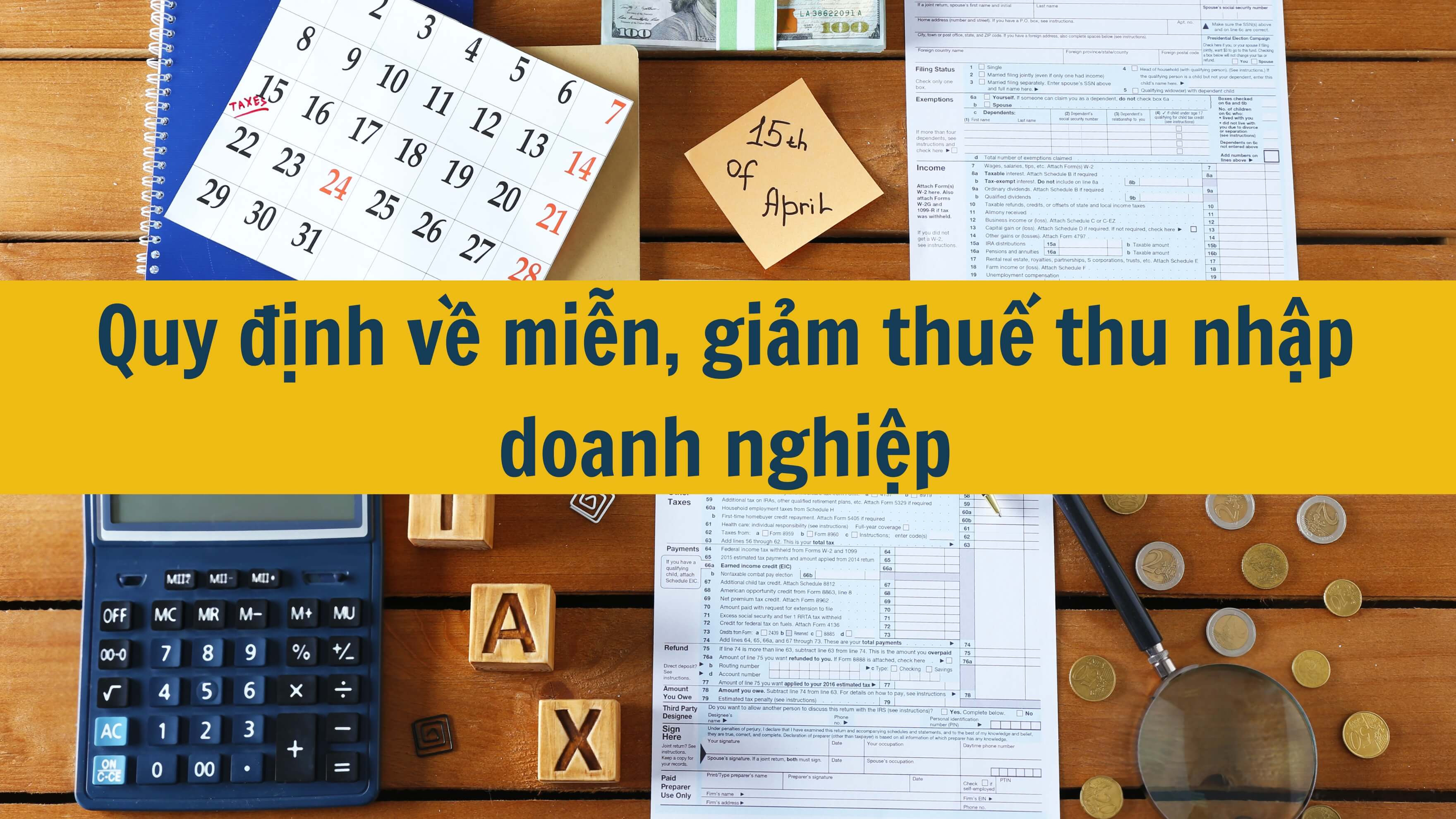
Quy định về miễn, giảm thuế thu nhập doanh nghiệp năm 2024
Môi trường kinh doanh luôn thay đổi và các doanh nghiệp luôn phải đối mặt với những quy định mới. Năm 2024, một trong những vấn đề được các doanh nghiệp quan tâm hàng đầu là những thay đổi trong chính sách thuế, đặc biệt là các quy định về miễn, giảm thuế thu nhập doanh nghiệp. Bài viết này sẽ giúp bạn cập nhật những thông tin mới nhất về chính sách thuế năm 2024. 15/11/2024Chính sách ưu đã thuế TNDN đối với dự án điện mặt trời mới nhất
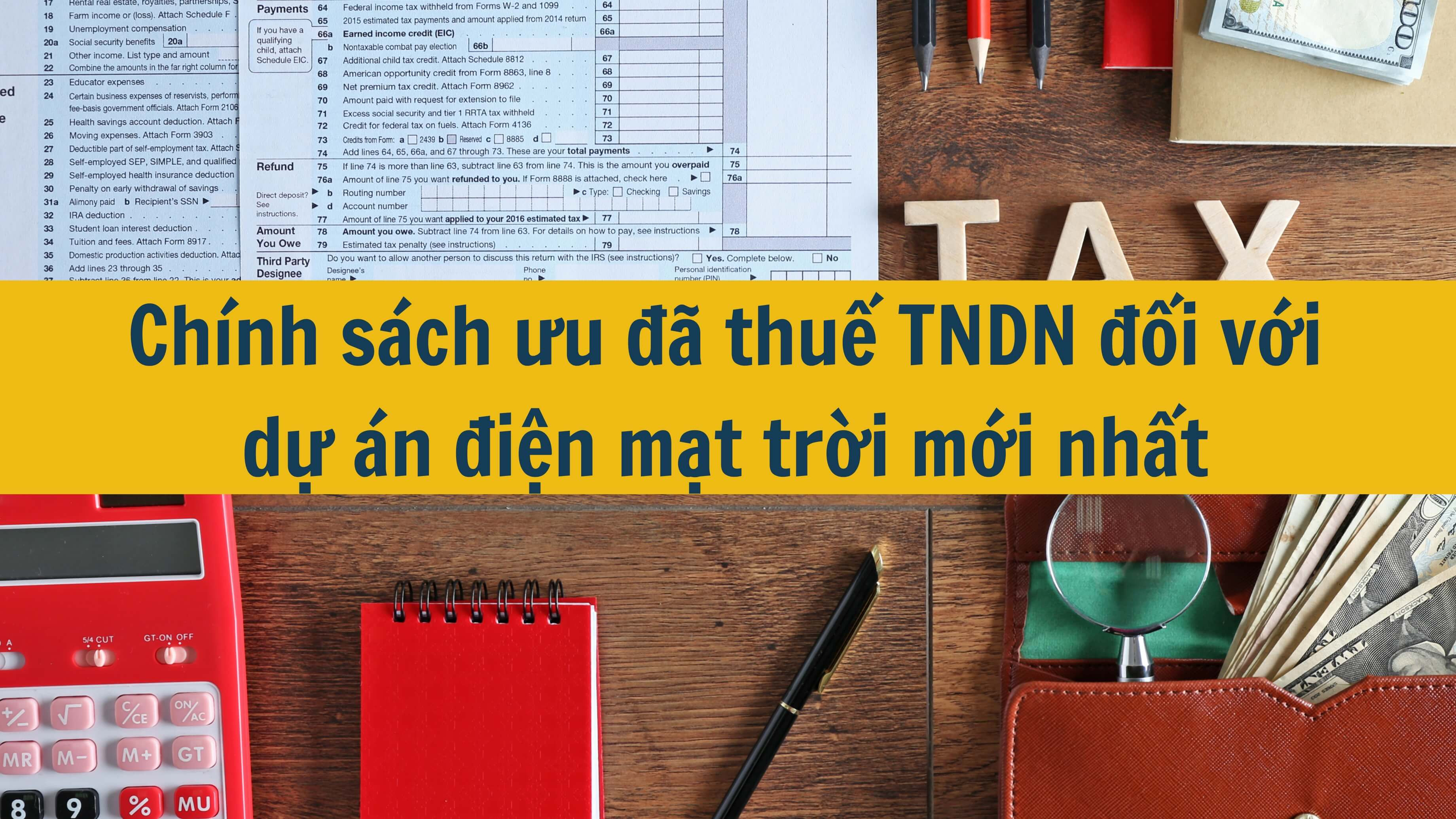
Chính sách ưu đã thuế TNDN đối với dự án điện mặt trời mới nhất
Năng lượng mặt trời, với những lợi thế vượt trội về tính bền vững và thân thiện với môi trường, đang ngày càng được các quốc gia trên thế giới quan tâm. Việt Nam cũng không nằm ngoài xu hướng đó. Chính phủ ta đã ban hành nhiều chính sách ưu đãi nhằm khuyến khích đầu tư vào lĩnh vực này, trong đó có chính sách ưu đãi thuế thu nhập doanh nghiệp (TNDN) đối với các dự án điện mặt trời. Hãy cùng tìm hiểu bài viết sau để hiểu rõ hơn về chính sách này. 15/11/2024Quy định giảm thuế TNDN trong năm 2024
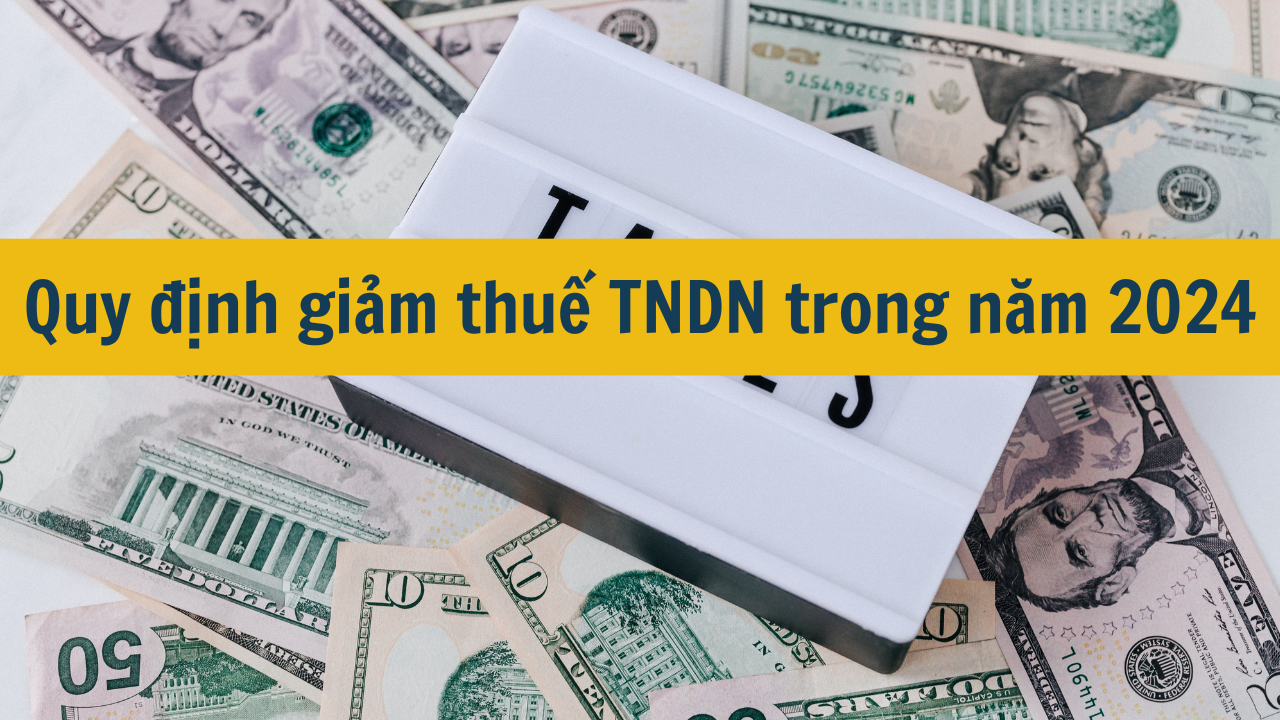
Quy định giảm thuế TNDN trong năm 2024
Thuế thu nhập doanh nghiệp là một trong những loại thuế trực tiếp quan trọng nhất, đóng góp đáng kể vào ngân sách nhà nước. Trong bối cảnh kinh tế hiện nay, việc điều chỉnh chính sách thuế TNDN không chỉ ảnh hưởng đến hoạt động của doanh nghiệp mà còn tác động đến sự phát triển chung của nền kinh tế. Bài viết này sẽ đi sâu phân tích những quy định mới về giảm thuế TNDN trong năm 2024. 10/11/2024Doanh nghiệp mới thành lập được miễn các loại thuế gì?
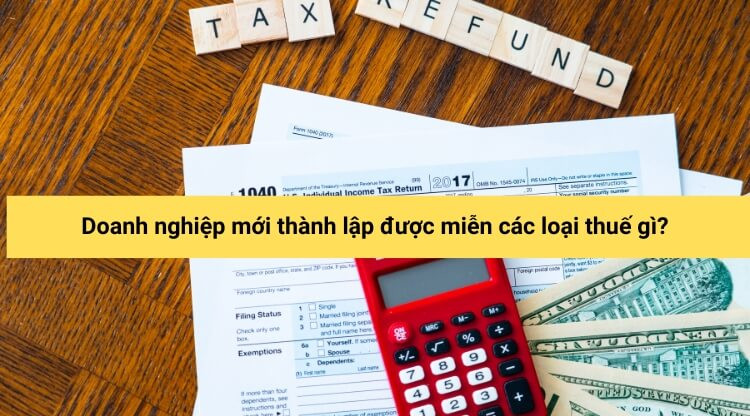
Doanh nghiệp mới thành lập được miễn các loại thuế gì?
Thành lập doanh nghiệp là một bước đi đầy hứa hẹn nhưng cũng không kém phần phức tạp. Một trong những vấn đề mà nhiều người quan tâm khi bắt đầu kinh doanh chính là các loại thuế phải nộp. Vậy doanh nghiệp mới thành lập sẽ được miễn những loại thuế nào? Bài viết này sẽ giúp bạn giải đáp thắc mắc này. 08/11/2024Điều kiện áp dụng ưu đãi thuế thu nhập doanh nghiệp là gì ?
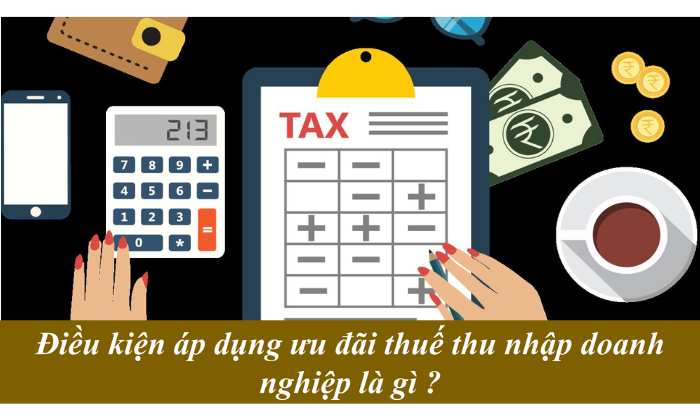
Điều kiện áp dụng ưu đãi thuế thu nhập doanh nghiệp là gì ?
Điều kiện áp dụng ưu đãi thuế thu nhập doanh nghiệp là gì ? 04/11/2024Khấu hao tài sản cố định là gì ? Khung trích khấu hao tài sản cố định mới nhất.
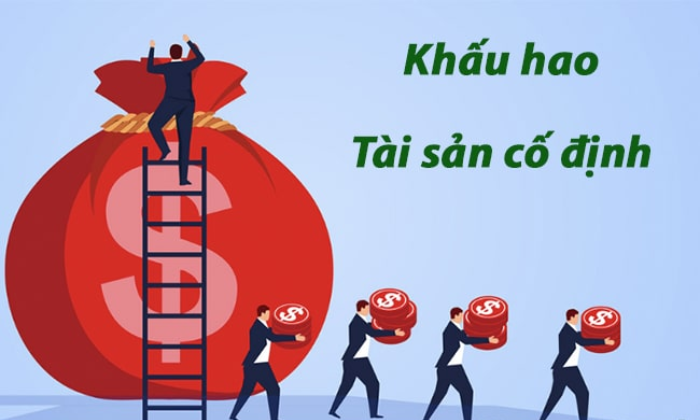
Khấu hao tài sản cố định là gì ? Khung trích khấu hao tài sản cố định mới nhất.
Khấu hao tài sản cố định là một khía cạnh quan trọng trong quản lý tài chính và kế toán của mỗi doanh nghiệp. Việc hiểu rõ về khấu hao không chỉ giúp doanh nghiệp tối ưu hóa chi phí và lợi nhuận, mà còn đảm bảo tuân thủ các quy định pháp luật. Trong bài viết này, chúng ta sẽ tìm hiểu chi tiết về khái niệm khấu hao tài sản cố định là gì và cách tính khấu hao một cách chính xác và hiệu quả. Những thông tin này sẽ cung cấp cho bạn một cái nhìn toàn diện và cụ thể, giúp bạn quản lý tài sản của doanh nghiệp một cách tối ưu. 03/11/2024Triệt sản là gì? Người lao động có được hưởng bảo hiểm y tế khi thực hiện biện pháp triệt sản không?


 Luật thuế thu nhập doanh nghiệp sửa đổi năm 2013 (Bản Word)
Luật thuế thu nhập doanh nghiệp sửa đổi năm 2013 (Bản Word)
 Luật thuế thu nhập doanh nghiệp sửa đổi năm 2013 (Bản Pdf)
Luật thuế thu nhập doanh nghiệp sửa đổi năm 2013 (Bản Pdf)